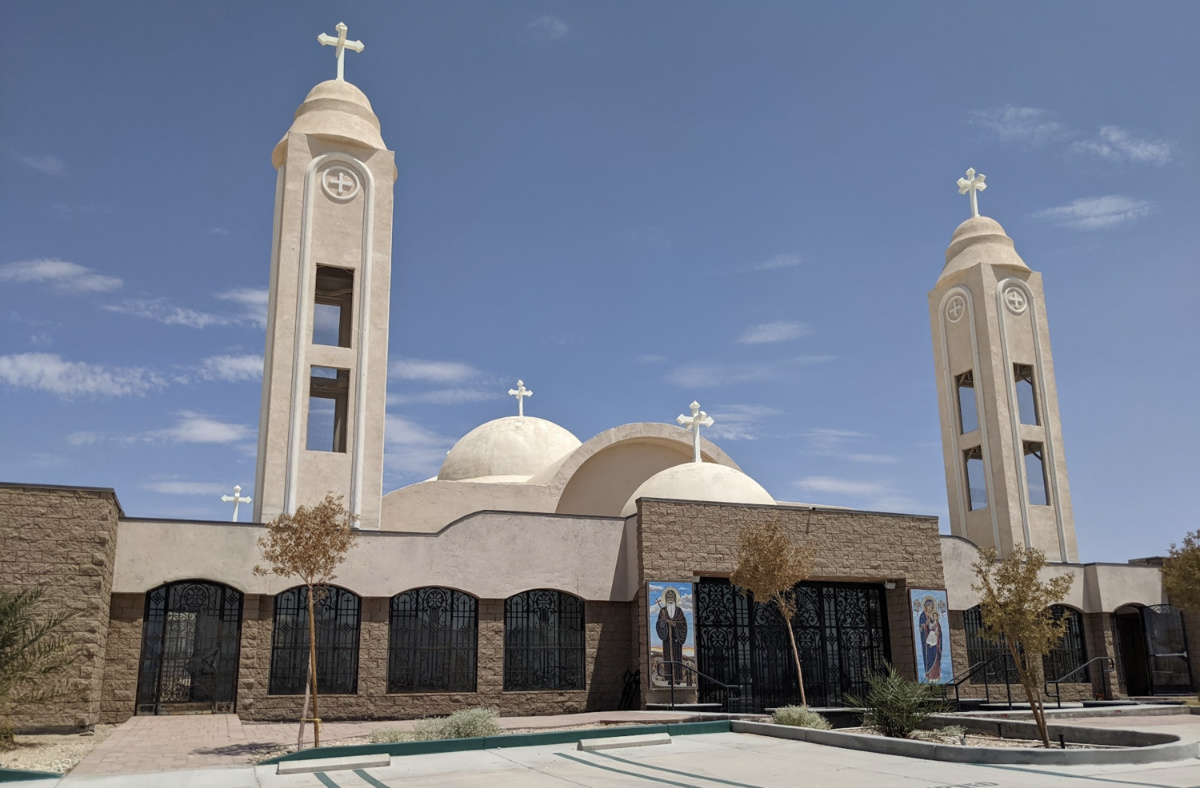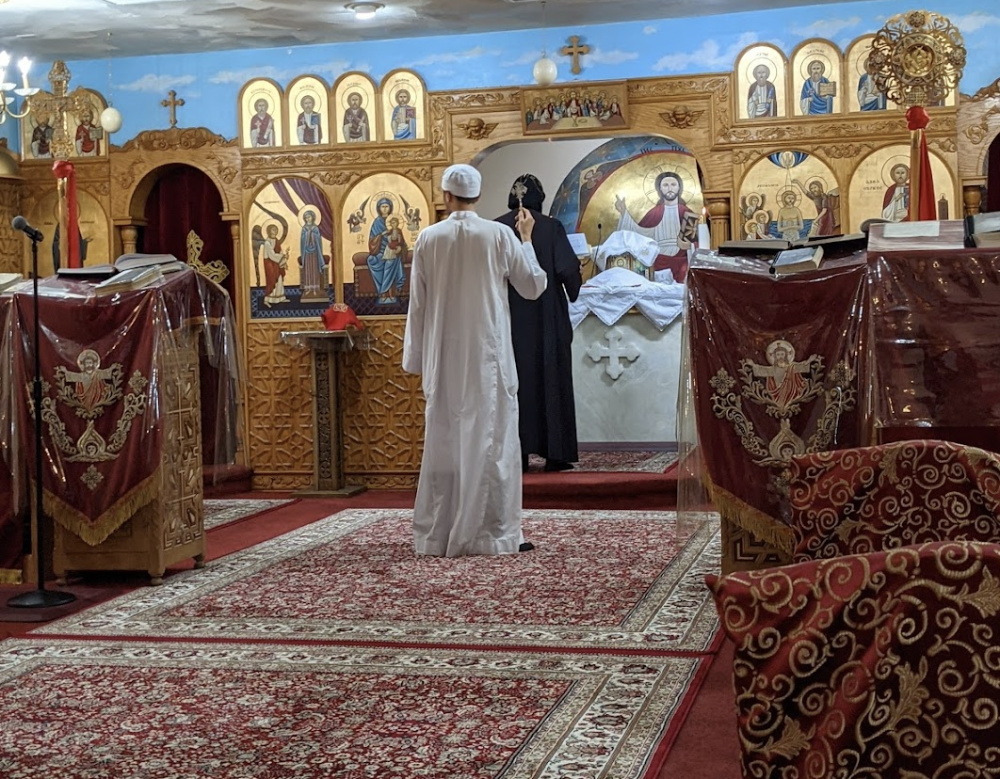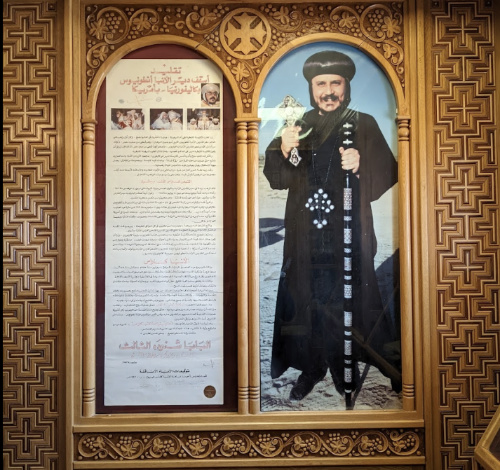
LIZA VANDENBOOM ASHLEY, writing for Religion Unplugged, visits the first Coptic monastery in the United States – the second oldest in the world outside Egypt…
Nearly 2,000 years ago in the Eastern Desert of Egypt, St Antony the Great retreated to the wilderness, pioneering monastic asceticism. According to retellings, he faced the Devil in the desert as Jesus did. In the late 1970s, two Coptic Orthodox Christian youth in California – far from Egypt – sought the same spiritual journey.
Today, 240 kilometres east of Los Angeles in an otherwise undeveloped desert, the first Coptic monastery in the United States – and second in the world outside Egypt – offers the monastic tradition of Egypt to America.
After nearly two years of isolation during the coronavirus pandemic, St Antony Monastery once again welcomes small groups of pilgrims to partake in traditional Coptic liturgy in a setting resembling the church’s homeland.

St Antony Monastery. PICTURE: Liza Vandenboom Ashley.
The Coptics have long esteemed the desert for its spiritual resonance. Amid sand and the severity of nature, one might more closely encounter God’s sovereignty and provision.
At the Council of Chalcedon in the year 451, the Coptic Church split from the other Eastern Orthodox churches over a disagreement regarding Christ’s nature. The Coptic Church promotes monophysitism, meaning “one nature”, in its Christology. While the Council of Chalcedon declared Christ has two natures, human and divine, the Coptic Church believes that at the incarnation, Christ’s two natures became one.
The most recent, nationally representative data from 2008 estimates the number of Coptic Christians in Egypt to be approximately four million. However, it does not reflect population shifts in the aftermath of the Arab Spring. According to estimates from the Coptic Orthodox Archdiocese of North America, there are more than 250 Coptic Orthodox Churches in the US.
The most recent, nationally representative data from 2008 estimates the number of Coptic Christians in Egypt to be approximately four million. However, it does not reflect population shifts in the aftermath of the Arab Spring. According to estimates from the Coptic Orthodox Archdiocese of North America, there are more than 250 Coptic Orthodox Churches in the US.
Eleven kilometres down a dirt road, swallowed by sand on either side, the dome of St Antony Church emerges from behind a metal gate. Beyond its doors, another dirt road gives way to palm trees, shrub bushes, rows of solar panels and a few experimental green houses. A wooden sign advises caution: “Scorpion, snakes, cactus. Watch your children. While driving be aware of soft sand”.
As the sun inches higher on the horizon, monks clad in white robes remove their shoes, kneel and enter the sanctuary for a 6am liturgy. Intricate red rugs fill the space between two rows of chairs, and icons of saints line the perimetre of the room.
At the back of the room, opposite the altar, a shrine to St Antony depicts him holding Matthew 19 in Arabic script. “Jesus told him, ‘If you want to be perfect, go, sell your possessions, and give to the poor, and you will have treasure in heaven. Then come, follow me,’” it reads.
Hearing this Scripture inspired St Antony, an heir of great wealth, to establish an endowment for his sister, abandon his riches and retreat into asceticism in the desert. While some other traditions disagree, the Coptic Church esteems St Antony as the first monk and codifier of monastic rules.
His retreat into the desert, temptation by the devil and eventual establishment of an ascetic community make him a central figure in Christian history and one of the first Desert Fathers.
Along with St Paul of Thebes and St Pachomius of the Thebaid, St Antony of Egypt conformed his spiritual life to Christ’s example of self-denial, poverty and service.
“It’s not that the Devil isn’t here,” said Deacon Pavli al-Antony, a leader at the monastery. “You can live a holy life in Las Vegas or in a desert monastery, and you will have temptation. But we think there is spiritual value in cultivating a life of prayer here as St Antony did in Egypt.”

A monk holds a cross and looks to an icon during the liturgy service. PICTURE: Liza Vandenboom Ashley.
In 1969, Rev Bishoy Kamel left his home in Alexandria, Egypt, and made the treacherous journey to St Mark Church in Los Angeles, California, one of the few established Coptic churches in the US at the time.
At the dispatch of former Coptic Pope Kyrillos VI, Kamel came to reinvigorate the local church with Egypt’s spiritual traditions. He performed liturgies with precision and brought the ethos of Alexandria to a sparse Coptic community in California.
Watching his ministry, two young men felt the call of monastic life. Atef Ishak and Magdy Saad, both from Egyptian families, desired to devote their lives to prayer and ascetic discipline, but the only Coptic monasteries sat on the other side of the globe.
We rely on our readers to fund Sight's work - become a financial supporter today!
For more information, head to our Subscriber's page.
One morning, a member of the St Mark Church committee, the administrative body responsible for logistics and oversight, sat at his breakfast table with a copy of the Los Angeles Times. An advertisement for 20 acres of land in the desert of Newberry Springs, California, caught his attention.
Devoid of trees, surrounded by rolling sand and distanced from any urban development, the land appealed to the Coptic tradition of desert asceticism. Without roads to access the land, Rev Arsenius Aziz of St Mark Church surveyed the land by helicopter. When the seller discovered the prospective buyers sought to turn the land into a monastery, he lowered the cost from $US30,000 to $US10,000. Adjusted for inflation, the discount amounts to slightly more than $US122,000 today.
In 1973, after purchasing the land, Kamel and the two young men he inspired toward monasticism prayed the first liturgy in open air. There were no buildings or trees in sight — only rolling sand and the promise of a spiritual oasis.
This climactic moment bled into years of ostensible stagnation. The land remained mostly dormant, with no buildings, plants or practicing monks on the property.
But in 1977, the Coptic population in California encountered a watershed moment. Former Pope Shenouda III made the first Coptic papal visit to the US, stopping in Newberry Springs to consecrate St Antony Monastery.
After his visit to the barren land, Shenouda returned to Alexandria committed to the monastery’s potential. He met an impressive man by the name of Antonious Markos, who led a successful ministry in South Africa without formal ministry education.
The Coptic church granted Markos a scholarship to study at Fuller College in Los Angeles. Before sending him off, Shenouda assigned Markos to spearhead the development of the monastery.
Markos partnered with St Mark Church to raise more than $US110,000 for the new monastery. Physical donations and volunteer labor, as well as cash donations, flooded in from the small Southern California Coptic community. Three months before the Feast Day of St. Antony in 1988, construction finished on St Antony Church at the epicentre of the monastery.
When word of the finished project reached Shenouda in Alexandria, he dispatched four Egyptian monks to germinate monastic life in California.

Bishop Karas, an ascetic and monk who served as abbot of the monastery, is memorialised at St Antony Monastery. He was the first bishop of the Coptic Orthodox Church in the United States. PICTURE: Liza Vandenboom Ashley.
After decades of staccato progress, St Antony Monastery became a beacon for Coptic pilgrims in America. Prior to the pandemic, the monastery would see more than 5,000 visitors some months, according to Rev Marcus al-Antony, a monk and historian at the monastery.
The two-hour liturgies performed with traditional robes, chanting and a mix of Coptic and Arabic language bring the spiritual traditions of Alexandria to Copts far from their ancestral home.
“Our faith was born in the desert, and there is something significant in practicing it here in the way our ancestors did,” Pavli al-Antony said. “People want to be part of it.”
As California restrictions eased, the monastery began to welcome small groups of visitors for liturgy and prayer again in late June.
Relying entirely on generosity from the Coptic community to forge life in inhospitable conditions, the monastery has made efforts to become more self-sufficient. Recently, it installed rows of solar panels and began experimenting with greenhouses to grow its own food.
“The desert provides spiritual food, but actual food can take more work,” Pavli al-Antony said.
Anyone seeking spiritual renewal or wanting to visit a relic of St Antony can schedule a visit to the monastery. Know that it’s a tumultuous drive through dirt roads and sand dunes – without cellphone service and with the occasional rattlesnake. The difficult pilgrimage is part of the experience, Pavli al-Antony said.
Women should wear loose pants or dresses that reach at least to their knees and tops that cover their shoulders and elbows. Men should avoid shorts, tank tops and overly casual clothing. All visitors should wear masks for the duration of the liturgy and while indoors.
Men and women are seated on opposite sides of the room during the two-to-three-hour liturgy. Depending on when you come, you could be the only visitor. While the liturgy is usually performed in a mix of Coptic and Arabic, when pilgrims come, the priest typically adds English to the mix.





